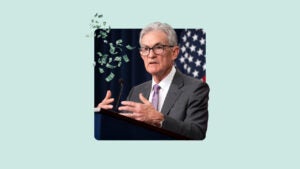Survey: In a cooling job market, 48% of workers plan to look for a new job in the next year

Following the COVID-19 recession, the job market boomed. Workers experienced a historic amount of bargaining power. Phrases like the “Great Resignation” and “quiet quitting” were part of Americans’ everyday lingo, and unemployment hit its lowest point in 54 years.
Today, that’s no longer the case. The U.S. job market has been slowly weakening over the last few months, as further evidenced by the latest jobs report. The economy added far fewer jobs than expected in July — just 114,000 — the third time in the past eight months that job growth has fallen below 200,000. The unemployment rate, meanwhile, unexpectedly jumped 0.2 percentage points to 4.3 percent.
But the slowing job market isn’t completely deterring workers from looking for new opportunities over the next year. Nearly half (48 percent) of Americans in the workforce (i.e., those who are employed full-time or looking for full-time employment) say they’re likely to search for a new job in the next 12 months, Bankrate’s new Employment Security Survey found. Many workers also say they’re likely to ask for higher pay and work flexibility in the coming year.
This is not the red-hot job market coinciding with the reopening of the economy a couple of years back. It is more in line with what we experienced before the pandemic.— Mark Hamrick, Bankrate Senior Economic Analyst
Bankrate’s insights on employment outlook in the U.S.
- Nearly half of workers have their eyes on new job opportunities, even as the job market slows. 48% of workers say they’re likely to search for a new job in the next 12 months, down from 56% in March 2023.
- Workers are prioritizing paychecks and flexibility. 43% of those in the workforce say they’re likely to ask for a raise at work, and 42% plan to ask for more work flexibility such as different hours and/or the ability to work from home or remotely more often.
- The job market has cooled since the Fed started raising interest rates in March 2022: 21% of those in the workforce say their employment/career situation has worsened since the Fed began raising rates in March 2022. 57% say it’s about the same, and 22% said it has improved.
- Amid the Fed’s rate hiking cycle, job security is a concern. 70% of workers indicated they had some level of worry about their job security since the Fed began raising rates in March 2022.
Nearly half of workers say they’re likely to search for a new job in the next year, especially younger workers
The slowdown in the job market is undeniable. With unemployment rising, fewer Americans quitting their jobs and slowing wage growth, workers no longer have the bargaining power they had following the pandemic. However, we’re far from a bad job market and Americans are still job hunting. According to Bankrate analyst Sarah Foster, the job market is likely normalizing back to what workers experienced before the pandemic.
“I’ve often speculated that workers might’ve gotten used to the historic amount of bargaining power that they had post-pandemic,” Foster says. “If you get a taste of what that’s like, it’s hard to go back. It might make a more ‘normal’ labor market feel artificially worse than it actually is.”
Over the next year, nearly half of Americans (48 percent) in the workforce say they’re likely to search for a new job, including:
- 23% who say they’re very likely
- 25% who say they’re somewhat likely
What’s notable is that this year’s figure is down from 56 percent when Bankrate last conducted this survey in March 2023, a possible sign of the cooling job market. Over half of U.S. workers (52 percent) say they’re unlikely to search for a new job in the next year, including:
- 25% who say they’re not too likely
- 27% who say they’re not at all likely
*(e.g., different hours, ability to work from home/remotely more often, etc.)
Note: Percentages are of U.S. adults who are employed full-time or looking for full-time employment.
Source: Bankrate survey, July 23-25, 2024
Younger workers — including millennials and Gen Z — make up a significant portion of the U.S. workforce and are more prone to job-hopping than other generations. Bankrate’s survey found younger workers are more likely than their older counterparts to search for a new job in the next year. Here’s the breakdown across generations:
- 64 percent of Gen Z workers (ages 18-27)
- 52 percent of millennial workers (ages 28-43)
- 45 percent of Gen X workers (ages 44-59)
- 25 percent of baby boomer workers (ages 60-78)
Higher pay or greater workplace flexibility are also big priorities for workers over the next year, especially among younger workers. Forty-three percent of those in the workforce say they’re likely to ask for a raise at work, while 42 percent plan to ask for more work flexibility such as different hours, and/or the ability to work from home or remotely more often.
Millennials and Gen Z workers are more likely to ask for a raise at work, compared with older workers.
- 52 percent of Gen Z workers
- 54 percent of millennial workers
- 34 percent of Gen X workers
- 25 percent of baby boomer workers
Some workers plan to make other career moves in the coming year. Twenty-five percent of workers are likely to quit their jobs in the next year, while 22 percent are likely to relocate for a job.
Roughly 3 in 10 workers (29 percent) will likely start their own business in the next year, with a higher percentage of young workers planning to become entrepreneurs, including:
- 41 percent of Gen Z workers
- 34 percent of millennial workers
It is refreshing and heartening to see so many individuals planning to start businesses. Innovation and entrepreneurism are key to the success of the American economy and financial markets.— Mark Hamrick, Bankrate Senior Economic Analyst
Roughly 1 in 5 workers say their employment situation has worsened since the Fed began raising rates
The Federal Reserve has been a major catalyst for the weakening labor market. As the Federal Reserve has hiked interest rates to combat inflation, the economy has slowed down, unemployment has risen and the number of jobs added monthly has declined.
Cooling the labor market down from a rapid boil to a low simmer has been one of the Fed’s goals. The Fed doesn’t want the job market to go back to being as hot as it was, for fear that it could make their inflation goals trickier.— Sarah Foster, Bankrate Economic Analyst
Roughly 1 in 5 workers (21 percent) believe their employment/career situation has worsened since the Fed began raising rates in March 2022. Meanwhile, the majority of workers (57 percent) say their situation is about the same, and 22 percent said it has improved.
Younger workers are more likely than older workers to say their career situation has improved since the Fed’s rate hiking cycle began.
- 30 percent of Gen Z workers
- 26 percent of millennial workers
- 15 percent of Gen X workers
- 15 percent of baby boomer workers
Note: Percentages are of U.S. adults who are employed full-time or looking for full-time employment.
Source: Bankrate survey, July 23-25, 2024
Since the Fed’s rate hiking cycle began, workers have some worry about their job security
Some workers are also feeling uneasy about their job security. Layoffs aren’t widespread and they remain at record lows, but “there’s been an undeniable social element to the fear of job security” in today’s job market, says Foster.
“Americans see the posts on LinkedIn. They often know someone who knows someone who’s been laid off,” she says. “Even back when unemployment was at a half-century low that it didn’t even eclipse pre-pandemic, Americans had a perception that the job market was much worse than it was.”
Seventy percent of workers have some level of worry about job security since the rate hiking cycle began, including:
- 42 percent who say their level of worry hasn’t changed
- 28 percent who say they are more worried
- 16 percent who say they are less worried
Only 15 percent of workers said they aren’t or haven’t worried about their job security since the Fed began raising interest rates.
Some generations are more concerned about their job security than others. Among generations who said they are more worried about their job security are:
- 36 percent of Gen Z workers
- 29 percent of Gen X workers
- 28 percent of millennial workers
- 18 percent of baby boomer workers
Notes: Percentages are of U.S. adults who are employed full-time or looking for full-time employment. Percentages don’t total 100 due to rounding.
Source: Bankrate survey, July 23-25, 2024
3 ways to make a successful career change in a cooling job market
The job market has slackened from red-hot levels, and finding a new job may be more challenging now than it was just a few years ago. But it’s not impossible. Here are three steps everyone should take when making a career change right now, especially in a weakening job market:
- Lean on your network: Your network is one of your greatest assets when trying to find your next job. Connect with old colleagues, reach out to people in your industry and contact recruiters to show you’re interested in new opportunities. They may be able to assist you in your job search and make the process go faster by fielding questions, giving you feedback on your resume or referring you to specific jobs.
- Have a well-stocked emergency fund: From application to hiring, it can take several months to secure a job. In case of emergencies, aim to have three to six months’ worth of expenses socked away in a high-yield savings account before you begin your job search. Emergency funds can be a lifeline if you experience a sudden job loss or a hefty unexpected expense while transitioning careers.
- Always negotiate for higher pay and better benefits: Job seekers may not have as much bargaining power as they did a few years ago, but it’s still important to negotiate. Recruiters often expect candidates to negotiate their compensation package, which is why you should come prepared with your ideal salary and other non-negotiables. Make sure your asks are backed by research, experience and conversations with people in your industry.






